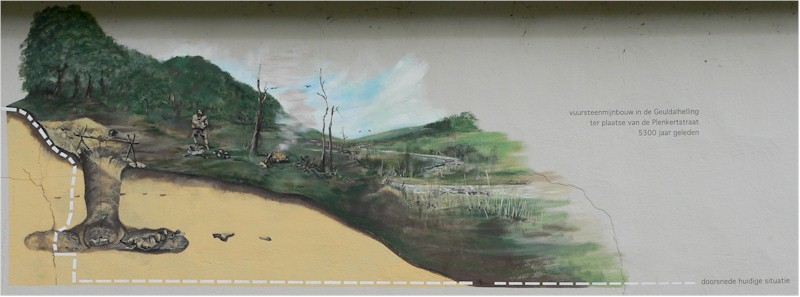Prehistorische Vuursteenmijn Valkenburg EarthCache
Prehistorische Vuursteenmijn Valkenburg
-
Difficulty:
-

-
Terrain:
-

Size:  (not chosen)
(not chosen)
Please note Use of geocaching.com services is subject to the terms and conditions
in our disclaimer.
Rijksmonument
"Prehistorische Vuursteenmijn Valkenburg aan de Geul"
Vlakbij het centrum van het touristische plaatsje Valkenburg aan de Geul vindt je één van de oudste mijnbouw activiteiten in Nederland
Zo'n 70 tot 65 miljoen jaar geleden, in een geologisch tijdperk dat we het Krijt noemen, werd in Zuid-Limburg een dik pakket van onder andere dood plankton afgezet op de bodem van een zee. Tijdens en na de vorming van kalksteen uit deze afzettingen ontstonden in bepaalde lagen ook vuursteenknollen en -platen. Vuursteen werd vanwege zijn hardheid en uitzonderlijk goede splijteigenschappen in de Prehistorie veelvuldig gebruikt voor de productie van gereedschappen en wapens. Lange tijd verkreeg men het materiaal door het simpelweg te verzamelen aan het oppervlak, of door het graven van meer of minder diepe kuilen (dagbouw). Ruwweg 6000 jaar geleden was de behoefte aan vuursteen dermate gegroeid, dat men er toe overging om de grondstof in Bijvoorbeeld Zuidwest-Limburg - bij Rijckholt ook ondergronds te winnen (mijnbouw). Enkele eeuwen later werden ook in de regio Valkenburg de eerste vuursteenmijnen aangelegd.
Betrekkelijk recent nog maar, in de 19de eeuw, is de hellingvoet van het Geuldal in de Plenkertstraat afgegraven. Daarbij zijn ongewild talrijke sporen van Prehistorische vuursteenwinning vernietigd. Ter hoogte van brouwerij "de Leeuw" bleef gelukkig een kleine strook met de resten van in totaal 7 mijnen gespaard. Op deze plek wordt ons tegenwoordig een blik gegund op de manier waarop prehistorische gemeenschappen rond 3300 V.C. voorzagen in hun grondstof behoefte. Zichtbaar zijn enkele door de 19de eeuwse afgraving aangesneden lage mijngangen, zogenaamde gallerijen, waar ooit vuursteenknollen werden gedolven. Bovendien zijn delen van 2 schachten onsloten, waar de mijnwerkers door afdaalden, om vervolgens naar het werkfront te kruipen.
Hoe deze eartcache te loggen:
Maak een foto van jezelf of een van je teamleden met op de achtergrond de mijnen. Plaats deze foto bij je online log.
en:
Email de antwoorden op de volgende vragen naar ons:
- Van welk materiaal werden de werktuigen gemaakt waarmee de mijnen werden gegraven?
- Waarom waren enkele van de gevonden schachten opgevuld met brokken mergel?
- Wat bewijst volgens jou dat deze schachten mijnen zijn en niet "gewoon" geologische orgelpijpen?
>>>>Wij stellen het op prijs wanneer je de geldende cache-etiquette volgt en de cache pas logt wanneer je antwoorden zijn goedgekeurd!<<<<
Wil je na het bezoeken van deze earthcache meer weten over de prehistorische vuursteenmijnen? Staatsbosbeheer organiseert regelamatig rondleidingen bij de vuursteenmijnen van Rijckholt, mee informatie en opgave via VVV Zuid-Limburg.

Rijksmonument
"Prehistorische Vuursteenmijn Valkenburg aan de Geul"
Near the centre of the touristic city Valkenburg aan de Geul you can find one of the oldest mining activities in the Netherlands.
Some 70 to 65 million years ago, during a geological era known as the Creataceous, this area was covered by sea. As Plankton and other sea creatures died, their remains sank to the bottom to form a thick layer of sediment. Later when this deposit was transformed into limestone, flint nodules and plates where created in some of the strata. Deu to its hardness and exeptional suitabilty for knapping, flint was widely used in prehistoric times for the production of tools and weapons. Initialy, the raw flint material was obtained by simply gathering it from the surface, or by quarrying it from open pits in the ground in an open mining process. About 6000 years ago the demand for flint reached such levels that it became necesarry to start mining underground to find the raw material in suffiecient quantity. A mine of that period is located at Rijckholt in the Southwest of Limburg. A few centuries later the first flint mines in the Valkenburg area were constructed.
Comparatively recently, during the 19th century or slightly earlier, the slope of the geul river valley in the Plenkerstraat was stripped, a process in which many traces of prehistoric flint mining were unwittingly destroyed. Fortunately, a small strip of land near the Leeuw Brewery, containing a total of seven mines, was spared, affording us an opportunity to take a closer look at the way in which prehistoric communities circa 3300 B.C. supplied themselves with some of the raw materials they wanted. We can see a number of the low mine galleries that were partly laid bare by the 19th century excavation works. It is here that the flint nodules were extracted. In addition, parts of two shafts have been uncovered that were used by miners to descend into the mine before crawling to the pit face.
How to log this earthcache.
Make a photo from yourself or one of your teammembers in front of the mine. Upload that photo to your log.
And:
Email the answers for the following questions to us:
- From what material where the tools made that where used for digging the flintstone mines?
- Why where some of the passages found filled with limestone?
- What proofs that these holes are dug out mine pits and not just geological organs?
>>>>We thank you for having the courtesy and patience not to log the cache untill we have approved your answers.<<<<
Liked this Eartcache? In Rijckholt you can visit a underground excavation of a prehistoric flint mine! For info about the tours you can contact the VVV-Zuid-Limburg.
Additional Hints
(No hints available.)